It’s not a pretty sight when you first exit the parking lot and walk toward the main structure at the recently opened National Palace Museum Southern Branch in Chiayi County.
What is supposed to be a lush, 50-hectare park surrounding the museum and its outdoor exhibit space remains largely barren and covered with straw, and when it rains, soil erosion creates muddy pools along the walkways.
There’s no getting around it — all visitors have to walk, bike or take a shuttle through a substantial stretch of this bleak landscape to reach the bridge that leads to the museum.
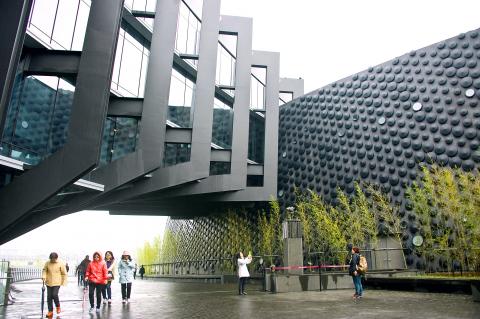
Photo: Han Cheung, Taipei Times
Granted, this part of the site — managed by a private company under a build-operate-transfer contract — is still under construction. Nonetheless, it creates a poor first impression for a state-of-the-art museum, well-designed and organized with thoughtful and impressive exhibits.
It has been a long time coming for the Southern Branch, which was first proposed in 2001 and scheduled to be completed by 2008. After various delays, it finally opened its doors on Dec. 28 last year.
TRADITION-INSPIRED MODERNISM
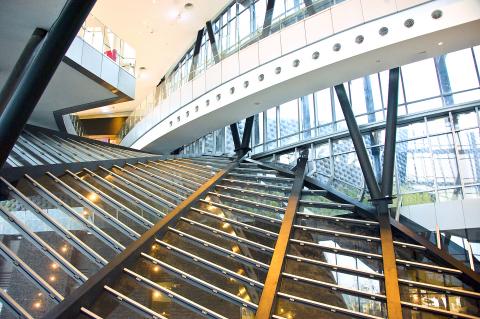
Photo: Han Cheung, Taipei Times
Things start looking much better as the main building designed by architect Kris Yao (姚仁喜) comes into view. Monochrome and abstract, it bears no resemblance to its traditional Chinese-style northern counterpart — perhaps alluding to their different natures: the main branch is focused on Chinese artifacts, while the southern branch covers all of Asia.
“We take a cultural exchange approach in curating our exhibits for the southern branch,” says Feng Ming-chu (馮明珠), the museum’s director.
The architecture is a bit of an optical illusion — from the parking lot, it appears that the entire building is a charcoal-black, sloped monolith covered with round discs — but as the path brings the visitor closer to the entrance, the other side appears as a glass facade. Further inspection reveals that the two sides are actually separate, curved structures that intersect at both ends.
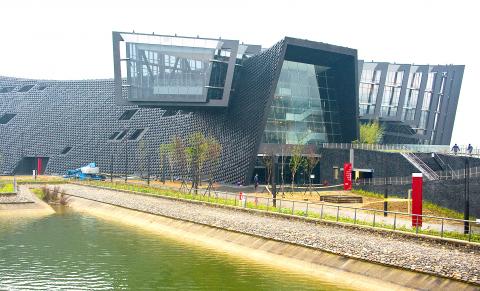
Photo: Han Cheung, Taipei Times
Despite its ultramodern look, the building’s concept is based on traditional Chinese calligraphy techniques. The charcoal black side represents nongmo (濃墨, thick ink), while the glass side is feibai (飛白, half-dry strokes), and the outdoor path in between the structures is xuanran (渲染, smearing).
Since the artifacts cannot be exposed to direct sunlight, they are housed in the black side, while the glass side contains the administrative offices, library and a spacious lobby.
The interior details are also symbolic: dragon, elephant and horse motifs represent the intersection of Chinese, Indian and Persian cultures. Cameras are not allowed in the exhibition space, and must be put in lockers — which are decorated with Islamic jade motifs that are part of the collection.
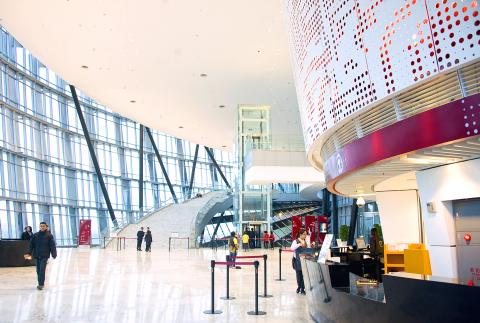
Photo: Han Cheung, Taipei Times
THE GOODS
A staircase leads up to the exhibition halls, containing 10 themed exhibitions — including Buddhist Art, tea culture, textiles, South Asian costumes and porcelains from ancient Japan, China and Korea. It takes more than an hour to quickly browse through everything.
The first room contains an exhibition on the history and culture of Chiayi, told through a combination of text, images, media and artifacts, including a decorated rare right-spiraling conch, which was brought here by Qing Dynasty general Fukanggan (福康安) to ensure safe passage across the Taiwan Strait on his way to pacify the Lin Shuang-wen rebellion (林爽文事件).
The spacious rooms each have unique details, from color coordination with the artifacts to creative displays such as video projection on boat sails and a world map made out of textiles from each corresponding region. In addition to the liberal use of multimedia, there are also tactile elements for each exhibit.
Other standout artifacts include the Tibetan Dragon Sutra, which contains more than 50,000 pages, hand-written in gold ink on cobalt paper. Almost 40,000 leaves of thin gold foil were used in the project commissioned by the Kangxi Emperor and completed by 117 monks.
There is also a blue-and-white porcelain Hanuman from Vietnam, which has been cartoonized and is the museum’s official mascot.
The Jadeite Cabbage, the main branch’s most prized artwork, is on loan here until October in an entire space of its own, though it is unclear why the visitor has to walk past several large-scale images of the piece before getting to the real thing. After October it will be replaced by the equally iconic Meat Shaped Stone.
The young ones can touch all the artifacts they want in the interactive children’s room, where they can play with various replicas, stage a puppet show and try on clothes from different Asian cultures.
The museum will continue to include Taiwan and Chiayi-themed exhibits — including a special exhibit in May based on the folk story that the Jiaqing Emperor secretly visited Taiwan and traveled to the south — which never actually happened, Feng says.
INFRASTRUCTURE
Although the museum is only 3km from the Chiayi High Speed Rail station, it feels like it is in the middle of nowhere.
For food, the museum cafe is home to the infamous NT$500 bowl of beef noodle soup, and other dishes do not come cheap, ranging from NT$200 to NT$400. Fortunately, they taste decent as museum staff say there is nothing else available in the immediate vicinity.
Feng says one of the museum’s goals is to stimulate the local tourism industry, but the infrastructure is not there yet. She says the Chiayi County government is working on increasing the number of buses as well as building a bicycle lane, and there are 13 local hotels under construction.
Ultimately, the museum needs to be promoted in connection with other tourist attractions in the area, such as the Aogu Wetlands (鰲鼓溼地) so people will stay nearby instead of attractions further afield such as Sun Moon Lake, Feng says.
The completion of the surrounding park should help, with hotels, a lakeside restaurant, markets and a cultural creative center scheduled to be complete by the end of 2017. Yet, that project, which has seen various delays, made headlines again last week as Chiayi County lawmakers voted to ask the museum to stop construction because they were unhappy that the land they provided is being used for commercial purposes.
Even without the infrastructure, the museum has already attracted more than 400,000 visitors. Despite its current shortcomings and ongoing controversies, what really matters is that it is indeed putting on a good show.

US President Donald Trump may have hoped for an impromptu talk with his old friend Kim Jong-un during a recent trip to Asia, but analysts say the increasingly emboldened North Korean despot had few good reasons to join the photo-op. Trump sent repeated overtures to Kim during his barnstorming tour of Asia, saying he was “100 percent” open to a meeting and even bucking decades of US policy by conceding that North Korea was “sort of a nuclear power.” But Pyongyang kept mum on the invitation, instead firing off missiles and sending its foreign minister to Russia and Belarus, with whom it
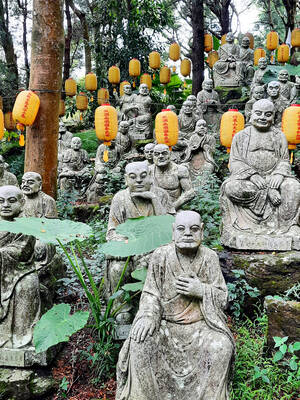
When Taiwan was battered by storms this summer, the only crumb of comfort I could take was knowing that some advice I’d drafted several weeks earlier had been correct. Regarding the Southern Cross-Island Highway (南橫公路), a spectacular high-elevation route connecting Taiwan’s southwest with the country’s southeast, I’d written: “The precarious existence of this road cannot be overstated; those hoping to drive or ride all the way across should have a backup plan.” As this article was going to press, the middle section of the highway, between Meishankou (梅山口) in Kaohsiung and Siangyang (向陽) in Taitung County, was still closed to outsiders
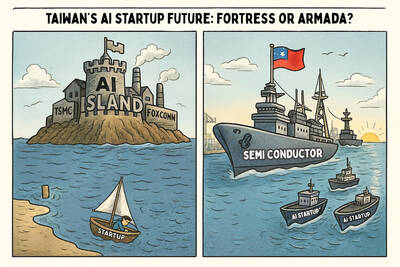
President William Lai (賴清德) has championed Taiwan as an “AI Island” — an artificial intelligence (AI) hub powering the global tech economy. But without major shifts in talent, funding and strategic direction, this vision risks becoming a static fortress: indispensable, yet immobile and vulnerable. It’s time to reframe Taiwan’s ambition. Time to move from a resource-rich AI island to an AI Armada. Why change metaphors? Because choosing the right metaphor shapes both understanding and strategy. The “AI Island” frames our national ambition as a static fortress that, while valuable, is still vulnerable and reactive. Shifting our metaphor to an “AI Armada”
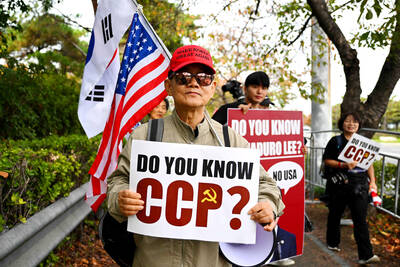
The Chinese Communist Party (CCP) has a dystopian, radical and dangerous conception of itself. Few are aware of this very fundamental difference between how they view power and how the rest of the world does. Even those of us who have lived in China sometimes fall back into the trap of viewing it through the lens of the power relationships common throughout the rest of the world, instead of understanding the CCP as it conceives of itself. Broadly speaking, the concepts of the people, race, culture, civilization, nation, government and religion are separate, though often overlapping and intertwined. A government